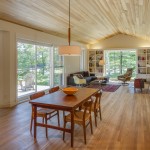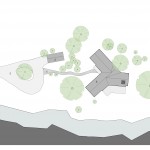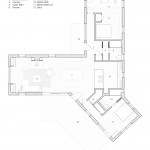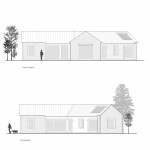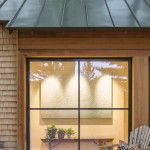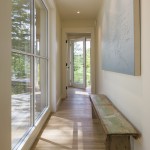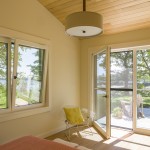Casco Bay Residence
Project Name: Casco Bay Residence
The coast of Maine is dotted with charming, old, and in many cases, quirky structures perched near the ocean’s edge that were built before modern shore-land zoning and resource protection was enacted. The footprint and form of these structures are grandfathered in their location, and can be renovated or rebuilt as required, but in a size no greater than 30% of the original building. These contemporary development rules result in a very specific and unique set of design restrictions when reimagining an old seasonal cottage or fishing hut, whose function or purpose was typically very different than a modern, year-round home. From this set of circumstances, the house on Casco Bay was borne.
Located on a site with captivating views of the Casco Bay, a stand of mature hardwood trees and a meadow, a small summer cottage evolved over many years, with additions and alterations, to become a hand-and-glove fit to its surrounding site. The Y shaped 1800 SF floor plan of the house frames distinct views of the site with its unique form, with the broad side of the house opening up to the view of the bay. A stand of hard wood trees grew up around the house (as close as five feet) over time, visually pinning the house to the site, towering over and embracing it. A more sensitive and unique relationship between house and site would not only be difficult to conceive today, but due to set-backs, also literally impossible to build.
The Architect was engaged to design and build a replacement for the existing home, converting it from a seasonal cottage to a two-bedroom year-round residence, that captured the charm and unique site relationships of the existing structure. Due to the zoning regulations, there was limited latitude in developing the building form, but the plan and location of windows could be adjusted to modernize the structure and improve its functionality as a year round residence. The zoning allowed for a 30% expansion, which was effectively utilized to improve the insulation values of the walls and ceiling, as the thickness of the new walls and ceilings required that area to maintain the existing usable floor area. Furthermore, the client requested that the mature hardwood trees surrounding the house not be disturbed through the demolition and reconstruction of the home. This was possible due to the slab on grade foundation system, as it did not require significant excavation around the house and the existing trees. Special attention was also paid to planning the site and tree protection so that construction work did not inadvertently damage any of the trees. All of this effort paid off, as no trees were damages or killed as a result of construction.
The unique, single story, Y shaped plan of the building had a distinct energy-efficiency disadvantage, in that relative to the floor area, there was significant building shell area. In Maine’s cold climate, that results in greater heat loss than a more compact building form. Because the options to reconfigure the floor plan of the building was not available, the energy-efficiency of the building was achieved through an improved building shell, combined with optimized passive solar gain where possible.
Passive solar heat was captured by adding large south facing windows at the living room and entry. Due to the limited space at the entry, a wall of thermal mass was added opposite the large south-facing window to help absorb and modulate the solar gains. Thermal mass is effective in tempering the temperature swings of the indoor air by absorbing the solar heat and releasing it later when the sun sets and the building begins to cool off. On the East facade, a large group of floor to ceiling windows were added to maximize the view to the bay. While those windows provide a stunning view, they are also prone to overheating from morning solar gains in the summer. To modulate those unwanted solar gains, retractable shades were installed on the exterior façade, neatly concealed behind the wood siding.
The material palate for the home was based on the local cottage vernacular, with simple painted built in cabinetry and clear finished wood on the floor and ceiling of the interior. The flooring is a simple quarter sawn white oak 2 1/4″ wide board with an oiled finish, complimented by a 1×6 oiled ash board on the ceiling. These two simple planes of wood are off-set by simple white painted walls and cabinets. The effect of the sandwich of the floor and ceiling planes of wood emphasize the horizontality of the spaces and sweeping views of the bay through the many large windows.
The exterior materials are traditional for the coast of Maine with unfinished eastern white cedar shakes, western red cedar boards and rafter tails and a standing seam painted metal roof. The facade materials will weather to a silvery gray overtime, and will allow the single story volume to recede visually into the site, as it’s predecessor did many years before.

